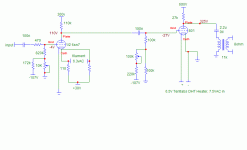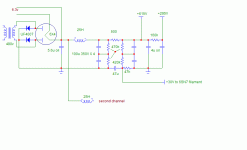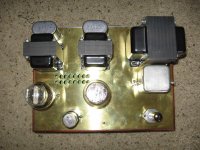Sheldon said:
If you like it and want to run that way long term, be sure to check out the reference I cited above on current vs. heater voltage. The 801 is rated for 85ma cathode current normally. According to Bench, if the voltage is lowered to around 6.5 or so, the max current should then be reduced to 70mA or less. Actually, reading the article, what you'd really want to know it the filament wattage. The current limit should be proportional to that.
Sheldon
Ahhh, that's a really good point - the Shishido design runs the 801A in A2 (220V, 90mA, +24V V_g). Maybe I'll just try 7V or so as I don't really want to damage the cathodes. They should hopfully be ok for a short term test? What do you think?
Cheers,
Pete
I'm by no means an expert, but even in my short tube experience, they seem very robust to many short term excesses. So I doubt that you'd have any problems with low filament wattage for a reasonable time. After all, when tubes were king power delivery was subject to a lot of variability.
Sheldon
Sheldon
http://members.aol.com/sbench102/dht.html
S bench is saying something about life when filament is starved.
Ciao
Gianluca
S bench is saying something about life when filament is starved.
Ciao
Gianluca
Lifetime when starved
Hi there, I didn't see any concrete conclusion in Steve's article - just that it was ok after 2 weeks which isn't really very long in the grand scheme of things.
I've read a number of articles stating that slightly under-voltaging (by up to 5%) the filaments will increase life whereas an increase of 5% will drastically shorten life. I always aim for very slightly under for this reason.
Starving them by running at 6.3V (16% under) is a different kettle of fish I suspect. Tolerance of this may also partially depends on the filament type. Thoriated Tungsten cathodes generally seem to be more robust and long-lived than oxide coated ones anyway, so lifetime may be less affected (if there is an effect) .
Thoughts?
Cheers,
Pete
Hi there, I didn't see any concrete conclusion in Steve's article - just that it was ok after 2 weeks which isn't really very long in the grand scheme of things.
I've read a number of articles stating that slightly under-voltaging (by up to 5%) the filaments will increase life whereas an increase of 5% will drastically shorten life. I always aim for very slightly under for this reason.
Starving them by running at 6.3V (16% under) is a different kettle of fish I suspect. Tolerance of this may also partially depends on the filament type. Thoriated Tungsten cathodes generally seem to be more robust and long-lived than oxide coated ones anyway, so lifetime may be less affected (if there is an effect) .
Thoughts?
Cheers,
Pete
No, actually no thoughts but just "rumors". I searched the books I dowloaded but ... no info on life expectation. Maybe if we had this mil
http://members.aol.com/sbench101/TubeMisc/tubelife.txt
BTW Sheldon are you happy with this amp?
Gianluca
http://members.aol.com/sbench101/TubeMisc/tubelife.txt
BTW Sheldon are you happy with this amp?
Gianluca
Gluca said:BTW Sheldon are you happy with this amp?
Gianluca
Of course I'm still tweaking it and have not had a lot of listening time. But with those caveats, yes, I think it will work well for my intended use. See this thread for the speaker:
http://www.diyaudio.com/forums/showthread.php?s=&threadid=69906&highlight="unity+horn"
Even with the pretty high noise (which I expect to reduce significantly) it sounds quite promising. The horn now has a passive crossover between high and mids, but I plan to use two of these stereo amps - one per horn with either digital or active analog crossovers between high and mid.
Sheldon
Starving them by running at 6.3V (16% under) is a different kettle of fish I suspect. Tolerance of this may also partially depends on the filament type. Thoriated Tungsten cathodes generally seem to be more robust and long-lived than oxide coated ones anyway, so lifetime may be less affected (if there is an effect).
Walter Johnson, an engineer at VOA Bethany, wrote an article about extending the life of high power direct heated transmitting tubes. It was ascerted that breaking in at normal voltages and then lowering it ~3-5% was best. The lowering was done in concert with carefull measuring on pairs in thier PP amplifiers, and lead to significantly improved THD. It was also stated that inrush current on startup was a major factor in filament life.
PDF link.
Attachments
Great paper. So using a current regulated heater is really what the tubes like as there is no inrush current.
As a matter of facts, my 801A required 5-10mins to reach the nominal voltage across the filament terminals but sound really improved after 1 hour or so.
Ciao
Gianluca
As a matter of facts, my 801A required 5-10mins to reach the nominal voltage across the filament terminals but sound really improved after 1 hour or so.
Ciao
Gianluca
Interesting read! Some concrete proof of this.
Most likely due to the series resistor changing value as it warms up? I noticed this with mine, too - the difference seemed to be a few tenths of a volt. How much variation did you get?
Didn't get a chance to try lowering the voltage. Will report back when I do....
Nice speakers too!
Cheers,
Pete
Gluca said:As a matter of facts, my 801A required 5-10mins to reach the nominal voltage across the filament terminals but sound really improved after 1 hour or so.
Most likely due to the series resistor changing value as it warms up? I noticed this with mine, too - the difference seemed to be a few tenths of a volt. How much variation did you get?
Didn't get a chance to try lowering the voltage. Will report back when I do....
Nice speakers too!
Cheers,
Pete
Walter Johnson, an engineer at VOA Bethany, wrote an article about extending the life of high power direct heated transmitting tubes
Cool! I knew my habit of pulling out the rectifier tube instead of turning the amp off, when I have to do something with my preamp was good for something
Bas Horneman said:That way the b+ goes off but filament remains on. No unecessary on-off cycles for me thank you very much.
The problem with only applying filament power and drawing no current is that in the long term you will "poison" the cathode. It's not recommended to do this for too long.
Cheers,
Pete
Oh..it's for a minute or 2 usually...It's not recommended to do this for too long.
Row numbers
6.5V at the start-up
7.0V after 5 mins
7.5V after 10 mins
It depends on how cold the filament is, and, yes, it must be linked to the filament resistance changing with temperature.
Bas you are not compliant with the Kyoto protocols! Save the planet, save energy, turn the filaments off
LOL

6.5V at the start-up
7.0V after 5 mins
7.5V after 10 mins
It depends on how cold the filament is, and, yes, it must be linked to the filament resistance changing with temperature.
Bas you are not compliant with the Kyoto protocols! Save the planet, save energy, turn the filaments off
LOL
Bas you are not compliant with the Kyoto protocols! Save the planet, save energy, turn the filaments off

Then again...do you know how much energy goes into producing a new tube?
Save the planet! leave your filaments on!
801A at low V_fil
Finally managed to get try this out with my amp.
I set the filament voltage on the 801As to 6.5V vs the normal 7.5V and let the amp warm up for half an hour before I did some listening comparisions. I switched back and forth several times to make sure. The filament colour was only affected slightly (although it was noticeable).
I have to say, the results were inconclusive. If I really had to make a choice, I think the standard 7.5V may *just* have had the edge, athough I can't be certain (it really was that close).
Note that this amp is a Shishido IITC style and runs the 801A at 220V/90mA in class A2. (and stays in A2 to within 4dB of max.)
In view of the A2 operation, I think it's likely that the results are different because the curves in the positive-grid region are affected differently, so the starving effect is not seen (or is different). It would be interesting to run an 801A on a curve tracer to see how the positive-grid region is affected by the starved filament.
Cheers,
Pete
Finally managed to get try this out with my amp.
I set the filament voltage on the 801As to 6.5V vs the normal 7.5V and let the amp warm up for half an hour before I did some listening comparisions. I switched back and forth several times to make sure. The filament colour was only affected slightly (although it was noticeable).
I have to say, the results were inconclusive. If I really had to make a choice, I think the standard 7.5V may *just* have had the edge, athough I can't be certain (it really was that close).
Note that this amp is a Shishido IITC style and runs the 801A at 220V/90mA in class A2. (and stays in A2 to within 4dB of max.)
In view of the A2 operation, I think it's likely that the results are different because the curves in the positive-grid region are affected differently, so the starving effect is not seen (or is different). It would be interesting to run an 801A on a curve tracer to see how the positive-grid region is affected by the starved filament.
Cheers,
Pete
Ok,
As described earlier, I did some playing with Steve Bench's method of hum cancelling. I think more reduction is possible, but that would have required more skill than I have and a scope to analyse the hum components. I had fun, but decided that DC would be best for now. I looked at a variety of ways to implement constant current, and it's fairly straightforward, IF you have volts to burn. Since my filament supplies are 7v nominal and I'm looking for about 6.5 DC, it becomes more difficult. I think there are ways around that if I wanted to rig up a negative supply. As I was running out of room in the chassis, I decided to give Guido Trent's DHT supplies a shot. They are compact, but even so, I had to remove the supplied heat sink, and mount them on to some sinks I built into the chassis for that purpose.
I had a slight glitch at first- an incorrect resistor had been mounted at Tentlabs, and that caused a voltage overshoot at turn-on. At Guido's suggestion, I replaced the accompanying cap to reestablish the proper time constant, and the overshoot went away. Once that was sorted, things ran fine. Residual AC on the outputs measures less than 0.4mV, and with a regular driver of 90+dB, I have to stick my ear practically on the thing to hear anything. With my horns (they roll of fast below about 300hz), I hear nothing, even with my head in the horn.
Here's the final amp schematic, bias supply is as shown before:
As described earlier, I did some playing with Steve Bench's method of hum cancelling. I think more reduction is possible, but that would have required more skill than I have and a scope to analyse the hum components. I had fun, but decided that DC would be best for now. I looked at a variety of ways to implement constant current, and it's fairly straightforward, IF you have volts to burn. Since my filament supplies are 7v nominal and I'm looking for about 6.5 DC, it becomes more difficult. I think there are ways around that if I wanted to rig up a negative supply. As I was running out of room in the chassis, I decided to give Guido Trent's DHT supplies a shot. They are compact, but even so, I had to remove the supplied heat sink, and mount them on to some sinks I built into the chassis for that purpose.
I had a slight glitch at first- an incorrect resistor had been mounted at Tentlabs, and that caused a voltage overshoot at turn-on. At Guido's suggestion, I replaced the accompanying cap to reestablish the proper time constant, and the overshoot went away. Once that was sorted, things ran fine. Residual AC on the outputs measures less than 0.4mV, and with a regular driver of 90+dB, I have to stick my ear practically on the thing to hear anything. With my horns (they roll of fast below about 300hz), I hear nothing, even with my head in the horn.
Here's the final amp schematic, bias supply is as shown before:
Attachments
- Status
- This old topic is closed. If you want to reopen this topic, contact a moderator using the "Report Post" button.
- Home
- Amplifiers
- Tubes / Valves
- 801 low power SE amp


